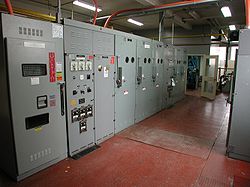
Electrical room
Encyclopedia

Electrical rooms typically house the following equipment:
- Electric switchboardElectric switchboardAn electric switchboard is a device that directs electricity from one source to another. It is an assembly of panels, each of which contains switches that allow electricity to be redirected. The U.S...
s - Distribution boardDistribution boardA distribution board is a component of an electricity supply system which divides an electrical power feed into subsidiary circuits, while providing a protective fuse or circuit breaker for each circuit, in a common enclosure...
s - Circuit breakerCircuit breakerA circuit breaker is an automatically operated electrical switch designed to protect an electrical circuit from damage caused by overload or short circuit. Its basic function is to detect a fault condition and, by interrupting continuity, to immediately discontinue electrical flow...
s and disconnects - Electricity meterElectricity meterAn electricity meter or energy meter is a device that measures the amount of electric energy consumed by a residence, business, or an electrically powered device....
- TransformerTransformerA transformer is a device that transfers electrical energy from one circuit to another through inductively coupled conductors—the transformer's coils. A varying current in the first or primary winding creates a varying magnetic flux in the transformer's core and thus a varying magnetic field...
s - BusbarBusbarIn electrical power distribution, a bus bar is a strip of copper or aluminium that conducts electricity within a switchboard, distribution board, substation or other electrical apparatus....
s - Backup batteriesBackup batteryA backup battery provides power to a system when the primary source of power is unavailable. Backup batteries range from small single cells to retain clock time and date in computers, up to large battery room facilities that power uninterruptible power supply systems for large data centers...
in a Battery roomBattery roomA battery room is a room in a facility used to house batteries for backup or uninterruptible power systems. Battery rooms are found in telecommunication central offices, and to provide standby power to computing equipment in datacenters... - Fire alarm control panelFire alarm control panelA Fire Alarm Control Panel , or Fire Alarm Control Unit , is the controlling component of a Fire Alarm System. The panel receives information from environmental sensors designed to detect changes associated with fire, monitors their operational integrity and provides for automatic control of...
s - Distribution frameDistribution frameIn telecommunications, a distribution frame is a passive device which terminates cables, allowing arbitrary interconnections to be made.For example, the Main Distribution Frame located at a telephone central office terminates the cables leading to subscribers on the one hand, and cables leading to...
s
In large building complexes, the primary electrical room may even house an indoor electrical substation
Electrical substation
A substation is a part of an electrical generation, transmission, and distribution system. Substations transform voltage from high to low, or the reverse, or perform any of several other important functions...
.
Regulations
The details of layout and construction of electrical rooms will be controlled by local building code and electrical code regulations. Requirements for an electrical room relate to fire safety and electrical hazards. An electrical room is usually required to be secured from access by unauthorized persons; these rules are especially strict where equipment within the room has exposed live terminals. Regulations may require two separate means of exit from a room where the power rating of circuits exceeds some threshold, to allow for quick exit in an emergency. Rooms containing oil-filled equipment may be required to have fire-resistant construction or active fire suppression equipment in the room and may be designated as an electrical vault. Since power distribution often requires large numbers of electrical cables, special measures for fire resistance of cables and cable trays may be also specified by regulations.In industrial buildings that handle flammable gases or liquids, or combustible powders, special electrical rooms may be prepared that have ventilation and other measures to prevent an explosion hazard that would otherwise exist with electrical equipment in hazardous areas
Electrical Equipment in Hazardous Areas
In electrical engineering, a hazardous location is defined as a place where concentrations of flammable gases, vapors, or dusts occur. Electrical equipment that must be installed in such locations is especially designed and tested to ensure it does not initiate an explosion, due to arcing contacts...
. For large installations, it may be less costly overall to use a special room than to install a large number of devices that are resistant to the hazardous conditions. Similarly, in wet or corrosive environments, electrical equipment may be separated in a room that can be protected from the atmospheric conditions.
Building code and electrical code regulations will dictate minimal working space around equipment to allow for safe access for maintenance. Practical design of an electrical room will consider layout of the initial equipment and allow for additions over the economic life of the facility.

